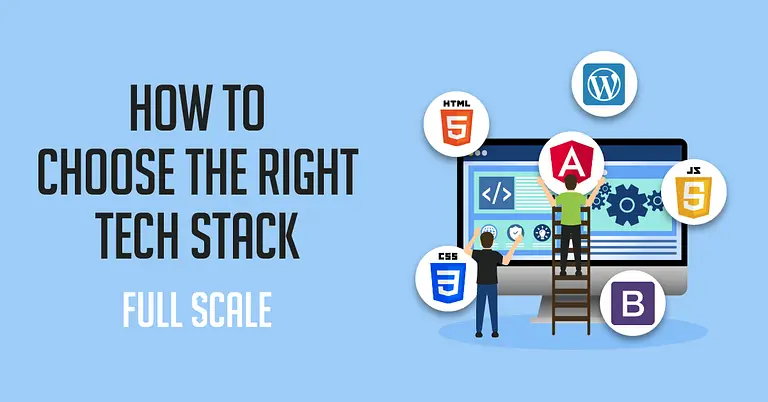Choosing the right tech stack is a foundational decision that can significantly influence a project’s success, scalability, and maintainability. A “tech stack” refers to the set of technologies—programming languages, frameworks, libraries, tools, and platforms—used to build and run a software application. This decision should not be based solely on trends or personal preferences but rather on the specific needs of the project, such as performance requirements, user experience, expected traffic, and integration needs. For instance, a real-time messaging app may require a different stack than a data-heavy enterprise dashboard. When deciding on a tech stack, it’s crucial to assess both front-end and back-end needs independently while also ensuring they can work together efficiently. Factors like time to market, development team expertise, and long-term maintenance must be weighed carefully.

The front-end technology stack governs how users interact with the application, so the choice of framework and tools should prioritize responsiveness, performance, and usability. Popular frameworks like React, Vue.js, or Angular each come with their own strengths and learning curves. React, for example, is known for its component-based structure and large ecosystem, making it ideal for dynamic user interfaces. If the project demands mobile responsiveness or a mobile-first design, additional tools like React Native or Flutter might be considered. Compatibility with design systems, browser support, and performance optimization techniques also influence front-end choices. The selected stack should enable clean, modular code and support future enhancements with minimal rework, reducing the technical debt as the project evolves.
On the back end, technology decisions involve choosing programming languages, server environments, databases, and APIs. For example, Node.js is a popular choice for real-time applications, while Python (with Django or Flask) is well-suited for data-driven platforms. Java and .NET are often used in large-scale enterprise applications. The database selection—whether SQL (like PostgreSQL or MySQL) or NoSQL (like MongoDB or Firebase)—depends on data complexity, structure, and scalability needs. Consideration should also be given to how the back end will handle authentication, authorization, data security, and integration with external services. Scalability, server deployment options (cloud-based vs on-premises), and performance under load must all factor into back-end decisions to ensure the application can grow effectively.
- Project Requirements Drive the Stack: The tech stack should be chosen based on the project’s functional and non-functional requirements, including scalability, performance, and user experience needs.
- Front-End Considerations: Frameworks like React, Angular, or Vue.js are commonly used for building responsive, interactive user interfaces, and should be selected based on project scope and team familiarity.
- Back-End Flexibility: Languages and frameworks such as Node.js, Python (Django/Flask), Ruby on Rails, Java, or .NET must be evaluated for handling server-side logic, data processing, and integrations.
- Database Selection Matters: Choose between relational (SQL) and non-relational (NoSQL) databases based on data structure, relationships, and scalability needs—for example, PostgreSQL for structured data or MongoDB for document-based storage.
- Team Expertise and Availability: The chosen stack should align with the team’s skills and the local or global talent pool to ensure development efficiency and ease of future hiring.
- Time to Market: If the project has tight deadlines, opt for frameworks and tools that allow for rapid development and prototyping without sacrificing quality.
- Community and Ecosystem Support: Mature technologies with strong community backing offer better documentation, libraries, and troubleshooting resources, which speeds up development and reduces risk.
- Scalability and Maintenance: Select a stack that supports scaling both vertically and horizontally, with long-term maintainability in mind to avoid technical debt.
- Security and Compliance: The tech stack should support modern security practices and meet any industry-specific compliance requirements, especially for applications handling sensitive data.
- DevOps and Deployment Integration: Ensure the stack works smoothly with CI/CD pipelines, containerization (e.g., Docker), and cloud platforms (AWS, Azure, GCP) for streamlined development and deployment workflows.
Finally, the chosen tech stack must align with the skills of the development team and the project’s long-term goals. A great stack on paper is useless if the team lacks experience or the hiring market lacks talent for that technology. Additionally, the maturity and community support of the technologies play a big role in sustainability—technologies with vibrant communities tend to offer better documentation, regular updates, and troubleshooting resources. It’s also critical to consider DevOps and deployment tools that fit the stack, such as Docker for containerization, CI/CD tools like Jenkins or GitHub Actions, and cloud platforms like AWS, Azure, or Google Cloud. A well-thought-out tech stack doesn’t just enable efficient development—it also provides the foundation for future-proofing, allowing the system to evolve with minimal disruption. Making this decision strategically can be the difference between rapid progress and long-term technical complications.